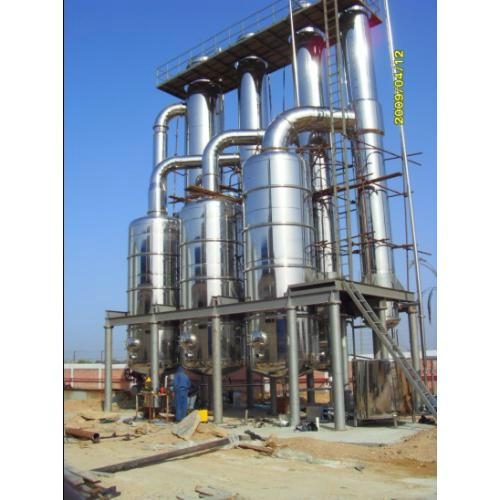advantages of falling film evaporator
View:
The falling film evaporator's structural composition.
The evaporator (heat exchanger), separator, preheater, condenser, condensate tank, circulation pump, and other components comprise the structure of a falling film evaporator.

Evaporator (heat exchanger): tube process through the liquid material, shell process through the heating steam, liquid materials from the top of the evaporator into, through the distributor into the heating tube, liquid materials along the heating tube downstream, and was heated evaporation, until the bottom of the heater, concentrated liquid and evaporation of secondary steam into the separator for separation, its bottom. The bottom has a level switch to control the water distribution.
The primary function is to heat and evaporate liquid materials.
Separator: a single-layer tank structure with the upper secondary steam interface connected to the condenser and the lower interface connected to the evaporator.
The primary function is to generate secondary steam after heating and concentration of liquid gas-liquid separation.
Preheaters are classified as either lying tube heat exchangers or plate heat exchangers. The tube process uses liquid material, while the shell process uses secondary steam generated by evaporation.
The primary functions.
(1) Pour the liquid material into the steam to pre-heat it.
(2) the secondary steam for cooling to facilitate recycling
Condenser: Condensers are further classified as horizontal tube heat exchangers or plate heat exchangers. Tube process through cooling water, shell process connected to the preheater shell process
The primary function: secondary steam will be condensed to facilitate recycling.
Condensate tank: the tank has a single-layer structure and a level switch to control the liquid level.
The primary function is to enable the automatic discharge of condensate in the tank by connecting with the pump at the outlet.
the benefits of a falling film evaporator
1. Because the residence time of a falling film evaporator is short, heat-sensitive materials will not degrade.
2A falling film evaporator consumes little vapor and has a high return water ratio. The falling film evaporator causes the liquid to flow downward in the form of a thin film, increasing the evaporation heat coefficient and the evaporation effect number under heat transfer temperature difference, saving heating steam. The greater the number of effects, the lower the final effect of secondary steam in the condenser loss ratio, resulting in a high return ratio for each ton of new steam.
3. The heat transfer coefficient of a falling film-type evaporator is high. The widely used external heat natural cycle evaporator has a heat transfer coefficient of 930 1754W/m2-K, while the falling film evaporator has a heat transfer coefficient of 1390 2910W/m2-K.
4Excellent secondary condensate quality from a falling film evaporator. Because the solution in the evaporation of the secondary vapor escape solution surface area and escape after the space is large, the secondary vapor escape conditions are calm, resulting in very little secondary vapor mist foam entrainment and high secondary vapor condensate quality.
the shortcomings of the falling film evaporator
1 The performance of the liquid distributor primarily determines the operation of a falling film evaporator.
2, falling film evaporator on equipment installation requirements are relatively high, particularly for verticality requirements.
3. A falling film evaporator is not appropriate for handling materials that are easily scaled or contain solid particles.
